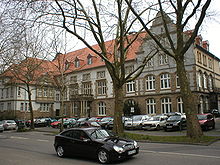Annen-Wullen
The rural community of Annen-Wullen emerged from the occupation of the Ruhr region by Napoleonic troops . In 1809 the communities were Witten , Annen , Rüdinghausen , Wullen and that today has become Bochum belonging Langendreer to Mairie Witten combined. After the troops withdrew around 1815 and the Mairie was dissolved, Annen and Wullen remained connected as a rural community.

history
The villages of Annen and Wullen were only brought together by the Mairie. Due to the rapid increase in population, caused by the establishment of several large mines in the second half of the 19th century, Annen-Wullen was given her own office in 1874. In the rural community, Wullen played the subordinate role from the start. In contrast to Annen, which developed into a city with the appropriate infrastructure in the course of industrialization, including business settlements, Wullen remained dominated by agriculture. On August 26, 1907, the district of Hörde complied with a request from the rural community to change the name Annen-Wullen to Annen .
Affiliations
In 1817 the rural community was assigned to the Dortmund district , and in 1887 to the new Hörde district . With the incorporation of Rüdinghausen in 1922 , the official area was significantly enlarged. Without city rights, however, the Annen office ultimately remained just an administrative structure. Above all, the neighboring city of Witten made no secret of its greed for Annen. In the course of the municipal reform on August 1, 1929, the district of Hörde was dissolved. This was accompanied by the end of Annen's office. Annen and Rüdinghausen were incorporated into Witten and received the status of districts, Wullen was downgraded to a district of Annen.
Individual evidence
- ↑ a b Stephanie Reekers: The regional development of the districts and communities of Westphalia 1817-1967 . Aschendorff, Münster Westfalen 1977, ISBN 3-402-05875-8 , p. 210 .